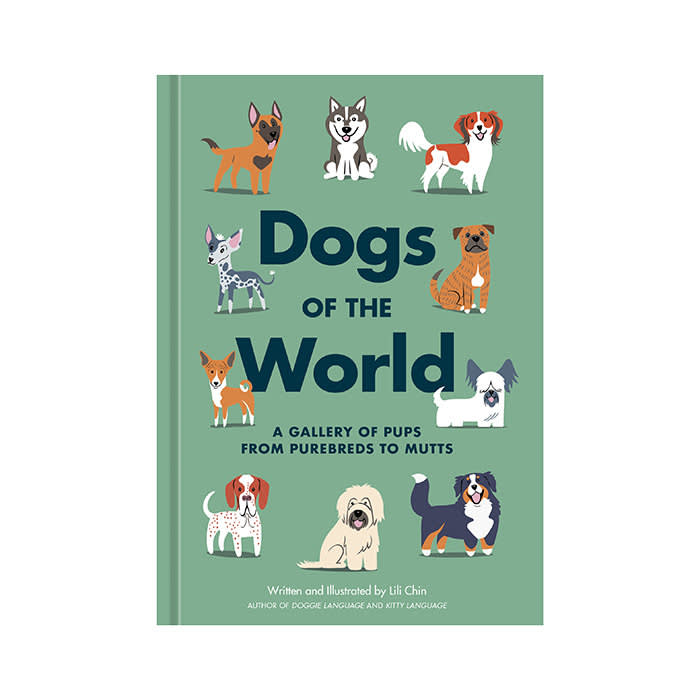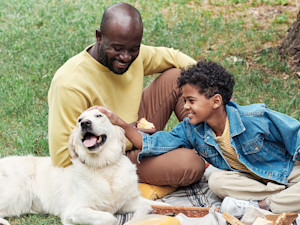This Adorable New Illustrated Book Will Introduce You to 600 Dog Breeds
Dog lovers need to get their hands on Lili Chin’s latest book, Dogs of the World.

Share Article
Some art lovers are generalists — jumping at the first chance they can get to go to a new exhibit or attend the latest gallery opening. But some of us, particularly dog people, are specifically interested in dog art. We love a good sketch of a pup and other renderings of our beloved creatures come to life. A photography museum with a dog exhibit? We’re in. One with colorful pup paintings and canine-shaped 3D art? Ummm, yes please.
So, yeah, you can say I was excited when I learned of accomplished artist-illustrator Lili Chin’s beautiful new bookopens in new tab, Dogs of the World: A Gallery of Pups from Purebreds to Mutts, which hit shelves (and online shopping carts) on April 15.
In addition to her drawings of over 600 dog breeds in the book, Chin includes mini histories about many of them. The book also covers the origin of breeds, facts about personality and genetics, the roles dogs have played dogs in people’s lives throughout history, and some info that may surprise you. (For example, did you know that only 15 percent of dogs worldwide are purebred?) Many readers will be thrilled to see so many beautiful drawings of mutts, mixes, crosses, village dogs, and landrace dogs (a variety of village dogs that have evolved within a specific region) along with all the renderings of purebred dogs.
About a decade ago, Chin began to draw dog breeds from all over the world — recreationally, in her now well-known minimalist style. She eventually put about 300 of her “for-fun” breed drawings together on a series of posters that connected her with dog lovers from around the world, who were excited to see their rare breeds represented. Those posters were the origin for Dogs of the World.

“I hope this book opens up awareness of a bigger and more diverse world of dogs to readers,” she says. Chin herself has only met about 100 of the breeds she features in the book but would love to meet as many as she can.
Chin spoke with me about her experience writing this book — which follows her 2023 book, Kitty Language and 2020’s Doggie Language — and the motivation behind it. It’s clear, from talking to her, that an enormous amount of thought went into every aspect of its creation from which dogs to include, the style and form of the drawings, and which of the many breed-facts to cover. Learn all about it here — and commission your own pet portraitopens in new tab from the author while you’re at it.
This interview has been edited for clarity and accuracy.
What did you learn from your research for this book that surprised or interested you the most?
I did so much reading! I went down so many rabbit holes that I don’t know if I could pick just one interesting thing. I was fascinated by what makes a breed a breed and how purebreds are different from mixed breeds and landraces and village dogs, and where all these categories and labels come from. I find it interesting that most breeds are only 200 years old and created in Europe and that many breeds were designed and celebrated based on dogs in old paintings or literature and for patriotic feelings.
How did you balance breed accuracy with your signature illustration style?
Part of the challenge I set [for] myself was to draw these dogs in a style that’s simple but recognizable. I was not aiming for accuracy. I was aiming to capture an overall look in a way that’s attractive and cute. I looked at many photos for each breed to get a feel for what the varieties are and the most common look for that breed.
I guess I’ve trained myself to be sensitive to the differences within breeds to some degree. For example, because my dog, Boogie, was a Boston Terrier, I was very connected to the Boston Terrier community and have drawn lots of Boston Terriers. I’ve never met two Bostons who look exactly the same!
Tell me about some of the decisions you had to make for this book, like the one to draw most dogs sporting low-maintenance, casual haircuts.
When I started working on these dog-breed drawings 10 years ago, at the time I was drawing a lot of stressed-looking dogs in dog-body-language charts for my clients who were dog behavior consultants. This was a hobby project, so I wanted to do the total opposite and make all the dogs look happy and cheerful.
Also, a lot of dog-breed media tends to present images of purebred dogs in serious poses, beautifully groomed with show clips, in “supermodel” mode. I wanted to do something that was more fun for me — draw these dogs looking casual and happy, mostly with short haircuts so we can clearly see their eyes and smiles.
Were there any breeds you originally planned to include but had to cut?
I did cut some breeds that look very similar. I included the Australian Shepherd, but not the English Shepherd or the American Shepherd. I included the Bull Terrier but not the Miniature Bull Terrier.
What are some common misconceptions about dog breeds you hope the book helps correct?
I think people invest more in the concept of breed to explain why their individual dogs do what they do than necessary. We love our breeds; it’s hard not to. But breed traits, occupations, roles, standards, ideal temperaments, stories, even nationalities — all these things are constructed and decided by people and change over time! There are differences within breeds depending on culture and specific environments.
How has your own understanding of dogs and the dog world deepened through this project?
I went through a range of emotions working on this project. I had a blast looking at pictures of dogs, chatting with different people, and doing the drawings, but through my research I had to confront a lot of sad and depressing truths in the history of dog breed creation. For example, learning about a long history of street mutts being impounded and killed because they were seen as less valuable than purebred pet dogs, learning about inbreeding and genetic diseases.
Sometimes, I struggled with balancing fun and cute art with more serious material that addresses dogs’ happiness and health. In the end I decided (and hope) that this [book people can give as a gift] is a great way to get important welfare information across.
How do you hope the book contributes to the understanding of global canine diversity?
There are so many dogs — more than we know! In addition to all the rare types of dogs that are not recognized by international breed registries, there are billions of street dogs and indigenous village dogs whose names and stories are rarely written about. Most people don’t hear about village dogs in the Western world, and I think this is what makes this book different and unique.
The book features images of friends and clients’ dogs, as well as your previously mentioned late pup, Boogie. I love how you made this book so personal in that way. What gave you that idea?
My publisher requested illustrations of dogs for the end papers. As I had so many portraits already done of clients’ and friends’ dogs — most of which were interesting-looking mutts — I took this opportunity to show these dogs off! Originally the book had a chapter on rescue dogs, but that was removed because I had gone over my page-count limit, so many of these rescue dogs appear in the end papers.
What’s the weirdest piece of feedback you’ve gotten about your dog drawings?
A few years ago, when I was working on the posters, a random person emailed me, very mad that I had drawn a tail on a Rottweiler. It was weird because it was so unexpected — this was a cartoon drawing. Most of the feedback I received over the years was from people asking about missing breeds, who wanted to see their dog represented.
Do you have any final thoughts you want to share about this book and your experience writing and drawing it?
Writing and drawing this book was an adventure that could have kept going on and on if not for my deadline and page-count limit! I hope Dogs of the World will make dog lovers happy, generate lots of curiosity, inspire people to ask questions and discuss what we know about dogs and breeds, and celebrate all kinds of dogs. It’s so exciting to see people share photos of their gorgeous dogs with this book.

Karen B. London, PhD, CAAB, CPDT-KA
Karen B. London is a certified applied animal behaviorist (CAAB) and certified professional dog trainer (CPDT) who specializes in working with dogs with serious behavioral issues, including aggression. She has written for a variety of magazines including The Bark, Clean Run, and the APDT Chronicle of the Dog, and has published in scientific journals including Behavioral Ecology and Sociobiology, Ethology, Ecology, and Evolution, the Journal of Insect Behavior, and Insectes Sociaux. She is the author of seven books about dog training and canine behavior, including the forthcoming My Dog's Mystery Adventure: And Other Stories From a Canine Behaviorist and Dog Trainer.
Related articles
![Couple smiling and holding their small fluffy dog.]()
Best Dog Breeds for First-Time Pet Parents
Please remember to look at shelters and purebred rescues for your dream pup.
What are Low-Maintenance Dog Breeds for First-Time Pet Parents?
Any of these breeds are a great option for adoption.
![Father and son have a picnic with their Lab dog.]()
The Best Dog Breeds for Families
Remember: You can find just about any breed you want at a rescue.





